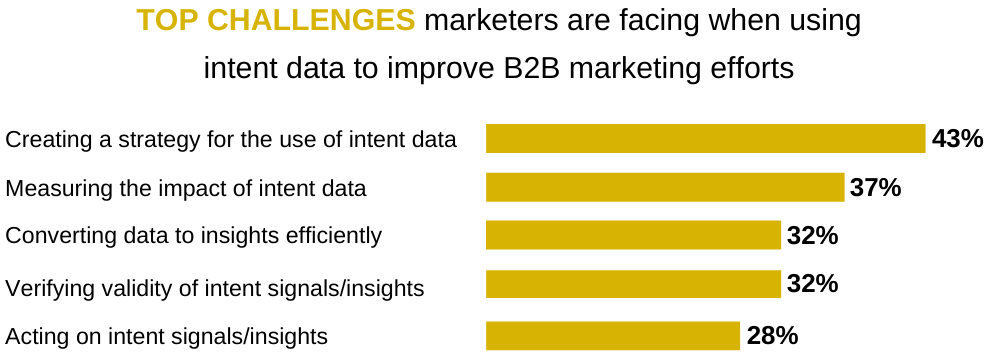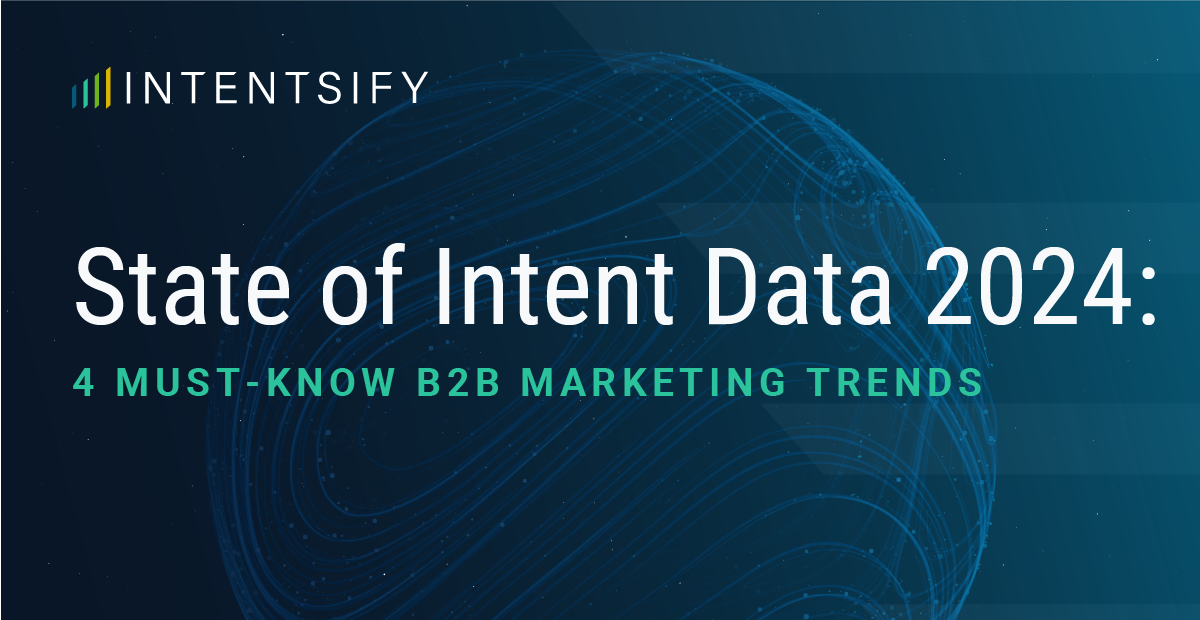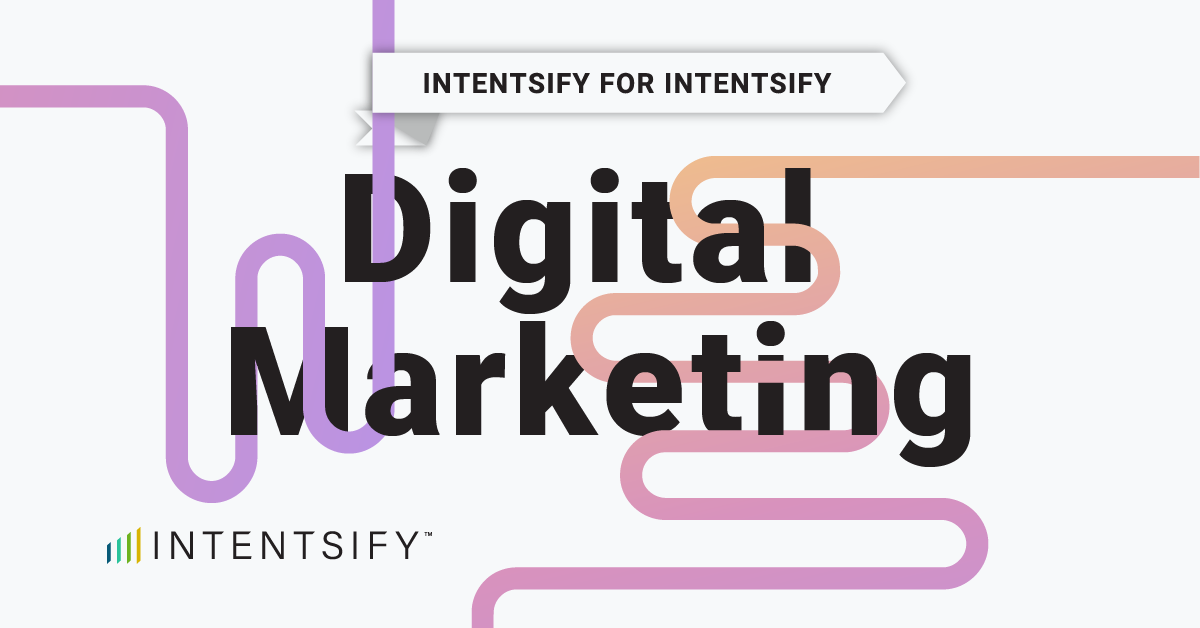Intentsify recently shared a research report that looked at the usage of intent data among 280+ B2B marketers. The report shed light on the biggest challenges they’re currently facing when using various intent data solutions.

It’s critical that marketers consider these issues when deploying their intent data solution(s), as respondents reported their greatest costs associated with these top challenges are wasted resources/staff time (59%) and missed opportunity for revenue (57%).
Intent data is meant to save resources and improve ROI. If you’re just replacing one inefficiency with another, you’re less likely to hit your intent data objectives. To help your team start (or stay) on the right track when deploying your intent solution(s), here are the best ways to overcome top intent data challenges.
Create a Strategy
Creating a strategy for the use of any tool is fundamental for ensuring a smooth path to success.
When creating a successful and scalable intent strategy, a good rule of thumb is to start with one or two initial use cases. Many teams first focus on account prioritization for paid media campaigns (such as content syndication). This allows your team to strategically allocate time, effort, and budget to those accounts currently researching your products/solutions, and thus more likely to convert to valuable sales opportunities. Then you should measure results, optimize efforts, and expand into additional use cases once your pilot program succeeds.
It’s also critical to ensure all teams who will be using the data are on the same page as soon as possible (preferably prior to implementation). For example, marketing teams using intent data most effectively bring sales leaders into the discussions early on—and vice versa. That’s because, for marketing teams to achieve their pipeline and revenue goals, their sales colleagues must know what intent data is, the value it brings, its core uses cases, and how to adjust their processes to reap the most benefits.
Such departmental alignment can best be achieved through persistent communication, education, and training on the subject. (Remember, intent data can only facilitate existing alignment rather than create alignment between teams and departments.) Although sales and marketing are often the main teams using the tool, don’t forget to include other relevant departments in these discussions, like customer success and media agencies.
Other key elements of an effective intent data strategy include:
- Establishing baseline performance metrics (which we’ll discuss in the next section);
- Identifying a common research path among your target audience (i.e., understanding your buyer’s journey);
- Understanding the intent topics most important to monitor;
- Aligning your intent strategy with related initiatives; and
- Identifying potential integrations of opportunities at scale.
Measure the Impact of Intent Data
Top-performing organizations also understand what they want to achieve with their solution(s) and set baseline performance metrics before implementation. This is important for identifying what’s working and what’s falling flat.
Although this seems obvious, data shows there’s still progress to be made. According to Demand Gen’s 2021 Survey Report, 86% of marketers indicated that advancing measurement is a growing priority, with 39% admitting their organization’s system for efficient measurement and attribution needs improvement.
To measure the efficacy of your intent-driven initiatives, you’ll first want to look at your pre-intent performance and document baseline metrics for all existing programs you currently have running. Next, define key performance indicators (KPIs) and metrics to track for each intent data use case. (Note that these will vary across use cases.)
For example, if you’re using the intent data for third-party demand gen (e.g., content syndication), you’ll want to track demand funnel conversion rates—such as conversions from marketing-qualified leads (MQLs) to sales-qualified leads (SQLs) to pipeline opportunities to closed-won deals. You may also want to measure target-account engagement and average deal size.
Once you’ve gathered enough data on the performance of both pre-intent and intent-driven programs, compare the results. Did lead-conversion rates improve? Did BDR email open rates and sequence replies increase? Benchmarking in this way helps you quantify the value of your intent data investments and enables you to make more informed and thoughtful decisions regarding when and how to scale your programs.
Verify the Validity of Intent Signals and Convert Data to Insights Efficiently
Verifying intent signals is key but can be challenging if marketers are only using one intent source to base insights on, as no one source of intent data can cover all the online research activities of an entire target audience.
Reaping the full benefits of intent data requires aggregating multiple sources to provide broad online coverage and verify the strongest buying signals being identified across multiple sources, which are far more likely to be accurate and actionable. Think about it: if two or more intent data sources highlight the same signals, it’s a substantially stronger indication of buying intent.
Further, when leveraging multiple sources, it’s easier to remove any outlier signals that aren’t very strong (i.e., not verified by another source). That’s why 88% of B2B marketers are currently leveraging 2+ sources of intent—with 33% utilizing 4+ sources—according to the same Intentsify survey.
Harsha Kalapala at TrustRadius substantiates this in a recent Demand Gen article:
“The impact of intent data compounds as you layer multiple sources to create an integrated funnel. As you demonstrate the impact of investing in this type of data, you can justify adding more pieces to the puzzle. Combining various intent data sources can give you a valuable competitive edge.”
Act on Intent Insights
As I’ve mentioned, using multiple intent sources is critical. But being that intent data is a relatively new (and complex) tool in the space, many marketers remain ill-equipped to properly aggregate, digest, and act on insights compiled across multiple sources—especially if they’re only accustomed to using one intent source.
Fortunately, Intentsify’s Intent Activation™ solutions exist to remove the headaches of automating, aggregating, and digesting numerous intent data sources. It layers complementary intent feeds to provide a more holistic and accurate view of target-account research activity, identifying the most valuable insights—validated by multiple sources—then automating the activation of insights across various use cases.
Making intent data actionable has never been easier. (Pro tip: refer to the Oracle case study to learn how their team is using Intentsify’s Intent-Activated Demand Generation solution to scale pipeline 35%).
Moreover, it’s important that organizations invest time and resources to the use of intent data. Some organizations have even built dedicated teams to focus on the issues of quick data aggregation, digestion, and insight distribution to activation points. But not all teams have the same means and should, therefore, focus on educating all stakeholders on what intent data is and how to use it for specific use cases—establishing processes and expectations to ensure quick and effective use.
To summarize, B2B organizations achieving big results with intent data have a few things in common:
- They’re able to aggregate, digest, and draw actionable conclusions from the data.
- They have good working relationships (i.e., “alignment”) with relevant teams (especially sales), which help them understand the nuances of intent data and how to act on intent signals in a variety of situations.
- They can convert data to insights to actions quickly.







